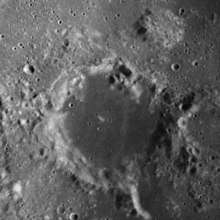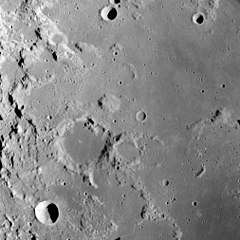Maraldi (lunar crater)
Maraldi is a worn, eroded crater on the western edge of the Sinus Amoris, in the northeast part of the Moon. To the west-southwest is the crater Vitruvius, and to the northwest lies the worn Littrow crater. Just to the northeast of the crater is the dome-like Mons Maraldi rise.
 Apollo 17 Mapping Camera image | |
| Coordinates | 19.4°N 34.9°E |
|---|---|
| Diameter | 40 km |
| Depth | 1.3 km |
| Colongitude | 325° at sunrise |
| Eponym | Giovanni Domenico Maraldi and Giacomo F. Maraldi |
The crater is named after two Italian-born French astronomers: Giovanni Domenico Maraldi and Giacomo F. Maraldi.[1]
Maraldi has a very worn outer wall that is deeply incised and has the appearance of a circular range of peaks rather than a crater rim. The interior has been flooded with basaltic lava, leaving a flat surface with a low albedo. There is a low ridge just to the northwest of the midpoint, and several tiny craters mark the floor surface.
Satellite craters
By convention these features are identified on lunar maps by placing the letter on the side of the crater midpoint that is closest to Maraldi.
| Maraldi | Latitude | Longitude | Diameter |
|---|---|---|---|
| A | 20.0° N | 36.3° E | 8 km |
| D | 16.7° N | 36.1° E | 67 km |
| E | 17.8° N | 35.8° E | 31 km |
| F | 19.2° N | 35.8° E | 18 km |
| N | 18.4° N | 36.8° E | 5 km |
| R | 20.3° N | 33.2° E | 5 km |
| W | 13.2° N | 36.1° E | 4 km |
The following craters have been renamed by the IAU.
- Maraldi B — See Lucian (crater).
- Maraldi M — See Theophrastus (crater).
References
- "Maraldi (lunar crater)". Gazetteer of Planetary Nomenclature. USGS Astrogeology Research Program.
- Andersson, L. E.; Whitaker, E. A. (1982). NASA Catalogue of Lunar Nomenclature. NASA RP-1097.CS1 maint: ref=harv (link)
- Bussey, B.; Spudis, P. (2004). The Clementine Atlas of the Moon. New York: Cambridge University Press. ISBN 978-0-521-81528-4.CS1 maint: ref=harv (link)
- Cocks, Elijah E.; Cocks, Josiah C. (1995). Who's Who on the Moon: A Biographical Dictionary of Lunar Nomenclature. Tudor Publishers. ISBN 978-0-936389-27-1.CS1 maint: ref=harv (link)
- McDowell, Jonathan (July 15, 2007). "Lunar Nomenclature". Jonathan's Space Report. Retrieved 2007-10-24.CS1 maint: ref=harv (link)
- Menzel, D. H.; Minnaert, M.; Levin, B.; Dollfus, A.; Bell, B. (1971). "Report on Lunar Nomenclature by the Working Group of Commission 17 of the IAU". Space Science Reviews. 12 (2): 136–186. Bibcode:1971SSRv...12..136M. doi:10.1007/BF00171763.CS1 maint: ref=harv (link)
- Moore, Patrick (2001). On the Moon. Sterling Publishing Co. ISBN 978-0-304-35469-6.CS1 maint: ref=harv (link)
- Price, Fred W. (1988). The Moon Observer's Handbook. Cambridge University Press. ISBN 978-0-521-33500-3.CS1 maint: ref=harv (link)
- Rükl, Antonín (1990). Atlas of the Moon. Kalmbach Books. ISBN 978-0-913135-17-4.CS1 maint: ref=harv (link)
- Webb, Rev. T. W. (1962). Celestial Objects for Common Telescopes (6th revised ed.). Dover. ISBN 978-0-486-20917-3.CS1 maint: ref=harv (link)
- Whitaker, Ewen A. (1999). Mapping and Naming the Moon. Cambridge University Press. ISBN 978-0-521-62248-6.CS1 maint: ref=harv (link)
- Wlasuk, Peter T. (2000). Observing the Moon. Springer. ISBN 978-1-85233-193-1.CS1 maint: ref=harv (link)
External links
| Wikimedia Commons has media related to Maraldi (crater). |
- Maraldi at The Moon Wiki
- Wood, Chuck (June 24, 2006). "Mons of Mystery". Lunar Photo of the Day. Archived from the original on March 20, 2007. Retrieved 2006-07-12.
